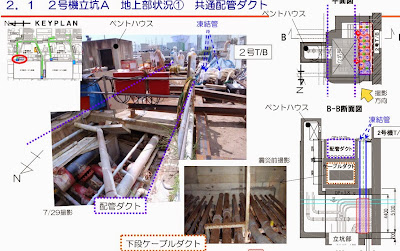Plan A, if you recall, was to freeze the highly contaminated water at the head of the trench right outside the Reactor 2 turbine building (Shaft A, on the northeast corner of the turbine building) to create an ice plug by placing several freezing pipes in the trench. Why is a plug needed? Because TEPCO wants to drain the highly contaminated water from the trench.
What TEPCO did not say was the existence of many obstacles at the trench head - i.e. numerous pipes for electrical wires and water transport. So the freezing pipes couldn't be placed in part of the duct where these pipes go through, and after two months of trying TEPCO admitted to the problem that the water remained unfrozen. Also, TEPCO admitted that there was a constant flow of water from the turbine building into the trench through many openings (pipes go through the building walls into the trench after all) that prevented the water from freezing. (Duh.)
(A red-shaded rectangle in the bottom right in the slide below is the intended ice plug)
So, on to Plan B.
Plan B, if you recall, was to dump crushed ice and dry ice to lower the temperature of the water in the trench to 5 degrees Celsius so that (in TEPCO's mind) the water would freeze even if there was a flow of water:
Plan B ran into trouble almost as soon as it started in late July, when crushed dry ice clogged the pipe in early August and crushed ice was seen floating around on the water surface (see photo). In the end, laws of physics prevailed and the contaminated water did not completely freeze, as TEPCO finally admitted, albeit in a very convoluted way in their report to Nuclear Regulation Authority on August 19, 2014 (Japanese only, PDF).
The report by TEPCO claims that 92% of the ice plug was formed in the Reactor 2 Shaft A. Well, a failure is a failure, as TEPCO admits the water continues to flow from the turbine building into the trench even at a faster speed now that the opening is narrower.
What's worse, in the open duct that TEPCO dug at a different location (southwest corner of the Reactor 2 turbine building), the water hasn't frozen at all despite 2 months of effort using the freezing pipes.
The water temperature remains mostly above 8 degrees Celsius:
and no sign of ice:
So now, time for Plan C.
So what is Plan C? Use some (yet to be determined) type(s) of filler to completely fill the trench head, while the water is still running.
So, what are the materials TEPCO says they are considering? According to TEPCO's report on August 19, 2014 (page 24),
sand (drawback: can't stop water, can't be dumped in large amount)
iron sand (can't stop water, can't be dumped in large amount)
sodium polyacrylate, aka "diaper polymer" (has to be used in combination with other methods)
grout (depending on the types, may not fill small/large gaps)
solidifying material (mixture of powder and liquid; powder may clog up the pipe)
waterglass (cannot fill openings)

Hmmm, diaper polymer, waterglass... where did I see this before?
April 2011, at the water intake for Reactor 2, where pouring diaper polymer and concrete in the pit didn't stop the extremely contaminated water from pouring into the plant harbor. That water did not stop until waterglass was injected into the base rock UNDERNEATH the trench.
I have a feeling they will soon need Plan D.
But why fight running water? Why can't they just pump out the water right there at the shaft?
Or as one of the long-time readers of this blog "netudiant" suggested before, why not build a mobile ALPS on a barge inside the harbor?
I think I know the reason: It simply doesn't occur to them. Just like it didn't occur to them to transport batteries for controlling the reactors without the required government permit, on March 12, 2011. (See my post from October 6, 2012.)









 Tokyo Time
Tokyo Time
![[Most Recent Quotes from www.kitco.com]](http://www.kitconet.com/charts/metals/gold/t24_au_en_usoz_2.gif)

